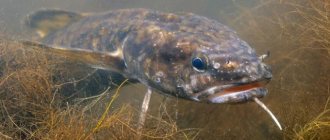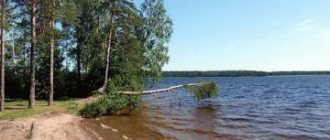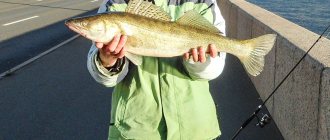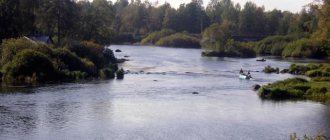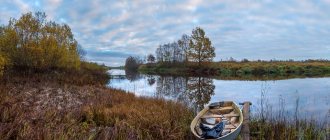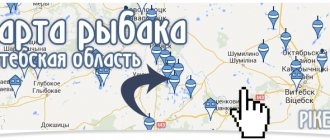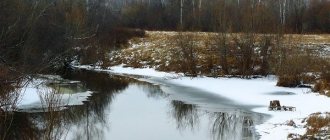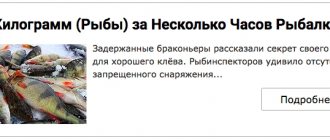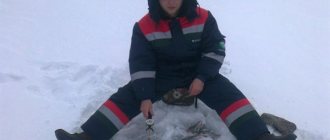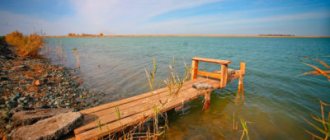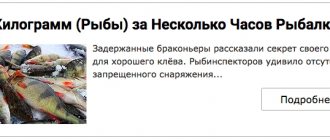- 2362
- Types of fish
Trout forms many subspecies and forms. The most interesting species for fishing are sea trout (or brown trout), lake trout and brook trout (or speckled trout).
Sea trout (trout) are found in the same rivers as salmon. The eastern border of distribution is the Pechora River.
The weight of trout ranges from 1 to 4 kg,
sometimes reaching
12 kg.
In the sea it lives in the coastal zone and rarely goes to the depths. To reproduce, at the age of 6–8 years, trout rise into rivers. The trip to the rivers begins in May - June and lasts 2-3 weeks.
The lifestyle and behavior in the river are very similar to the life and behavior of salmon, only in most rivers, trout, as opposed to salmon, continue to feed.
Where is the best place to fish in the Leningrad region?
We publish some “fishing” places in the region.
Residents of St. Petersburg and the Leningrad region love fishing so much that even among women there are avid fishermen. In addition to wild places, in the Leningrad region there are civilized fishing recreation centers where they can rent a boat or a place to stay overnight. There are many lakes and rivers rich in fish in the region, and even in the Neva, fishermen manage to catch something, although it is better not to eat such a result of their labor themselves, but to give it to the cat as food.
So, in addition to the Gulf of Finland, Ladoga and a “piece” of Lake Onega, in the region there are also such rivers as the Svir, Vuoksa, Neva, Volkhov, as well as about 25 thousand more large and small rivers. And about 40 thousand lakes. As for St. Petersburg, almost any Neva embankment can become a fishing spot (the best “bite” occurs in the morning and evening). On the Malaya and Srednyaya Nevka, they catch chubs and large pikes with spinning rods; with the help of bottom fishing rods they catch perches, roaches, bream and even whitefish. At the mouth of the Bolshaya Nevka, chub, redfin, ide, and bream are caught using a bottom fishing rod with bait. The most polluted rivers of St. Petersburg are the Slavyanka, Okhta, Izhora, Karpovka, Okkervil - you should not fish here. The river network is distributed evenly throughout the Leningrad region, but lakes are most concentrated in the north of the Karelian Isthmus, as well as in the northeast of the region, in the Podporozhsky district. The largest natural reservoirs with a surface area of more than 10 sq. km and an average depth of 10 m are located in the north - Vuoksa, Sukhodolskoye, Pravdinskoye, Otradnoye, Balakhanovskoye, and in the Luga region - Vyalye, Samro, Vrevo, Cheremenetskoye, Syabero. In the east of the Leningrad region there are many lakes and rivers where people rarely set foot. There you can catch grayling, brook trout and even salmon. Here are some popular rivers where you can catch excellent fish:
Trout fishing
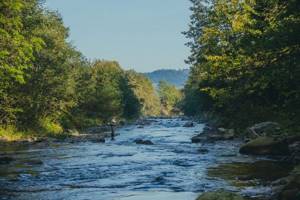
Fishing for brown trout and lake trout in rivers is no different from salmon fishing. Trout fishing in calm waters has its own characteristics.
In the lakes of Karelia it is most often caught on the track. Spinner baits used are oscillating brass or red copper, sometimes tinned on one side. The most common spinners are 60–80 mm
and 0.8–1
mm
, such as “Geneva”, “Schweden spinner” or “Norich”. Sinkers are not used, since trout stay in the upper layers of water, and the depth of immersion can be varied within small limits by changing the length of the release. It is necessary to install an anti-twist, since even oscillating spoons sometimes turn and twist the line. Fishing on the path is only possible in windy weather, as in quiet, cautious trout are afraid of a floating boat.
Much more successful and interesting is fishing with a spinning rod, which can be used to successfully fish both in windy and calm weather. The tackle should be such that it can be used to cast far, so that the bait falls into the water with a slight splash and plays well at an average retrieve speed. This is easiest to achieve by using heavy lures without an additional sinker. The narrow oscillating spinnerbait “pig” with a length of 60–65 mm is especially good,
20
mm wide,
about 3
mm thick and
weighing 30–35
g.
The pig is best made of red copper, tinned or silvered on the inside.
It’s also not bad to fish with a “three-grid” weighing 25–30 g. The line should be thinner - a nylon core with a diameter of 0.4 mm.
Since trout are found only occasionally in the coastal zone, and usually stay in the open part of the lake, you need to fish with a spinning rod from a boat.
Fishing for trout on free-floating mugs and on mugs mounted motionless on anchors is very exciting. The mugs are equipped with three to four small and inconspicuous floats, which are placed 1 m
from each other between the circle and the hook.
The purpose of the float is to distance the live bait from the circle, which, when released a short distance (usually 1–1.5 m),
the cautious trout is afraid of.
The best bait for catching trout with mugs are vendace, smelt, bleak, and dace.
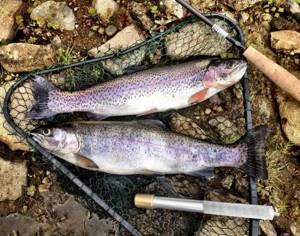
Trout fish for live bait and spinners from the opening of reservoirs until freeze-up. The best fishing time is in the summer in June, and in the fall - starting in the second half of August. During the day, trout feed more intensively in the morning. On white nights it can also be caught at night.
In addition to fishing with live bait and spoons, trout can be caught in the summer using natural insects and artificial flies.
It is not possible to catch it in the lakes with fly fishing: the trout does not come close to the shores, but it is afraid of the boat and stays away from it beyond the usual fly casting range. Therefore, in lakes you should fish with a water kite or with a sinker float...
Pied fish are most often caught using an earthworm or a fly fishing rod.
In the summer - from May to September - fly fishing for trout using natural and artificial insects is the most interesting. In spring and autumn, fishing is sporadic. Walking fishing gives the best results.
In summer, pied fish should be caught in the morning and evening, and the hotter the weather, the shorter the zhor. In the north it takes well on white nights. In spring and autumn, as well as in cold cloudy weather, it takes almost the entire day.
Share link:
- Click to share on Twitter (Opens in new window)
- Click here to share content on Facebook. (Opens in a new window)
- Click to print (Opens in new window)
- Click to share on LinkedIn (Opens in new window)
- Click to share on Telegram (Opens in new window)
- Click to share on WhatsApp (Opens in new window)
- Click to share on Skype (Opens in new window)
- Send this to a friend (Opens in new window)
Lake Lipovskoye
It is located in the north of the Kurgalovsky Peninsula and is connected by a wide channel to the Gulf of Finland. You can get to the lake like this: from St. Petersburg through Lomonosov -> Sosnovy Bor -> Ust-Luga. Then the route turns north directly towards the channel. The shores of Lake Lipovskoye are practically uninhabited. You won’t be able to get to the lake without a special pass—it can be issued in the city of Lomonosov. The constant mixing of huge masses of water makes it brackish and sea-like in the lake, which allows both freshwater and marine fish to feel comfortable. The ichthyofauna of the lake is strongly influenced by the shore of the Gulf of Finland. There are ruffe, bream, pike perch, pike, roach, silver bream, and bleak.
Lake Vyalye
Currently, the reservoir is slowly overgrown, and a significant part of it has already become the Mshinsky swamp. In some places, especially on the eastern side, only many kilometers of trails lead to the lake. The lake can be reached from the Chasha or Mshinskaya railway stations, and further along forested, swampy paths. The lake cannot be reached by any car, therefore the state nature reserve of federal significance remains untouched. The length of Vyalje is 8.7 km, the greatest width is 3.4 km. The bottom is covered with silt. There are ruffe, bream, pike perch, pike, roach, and bleak.
Fishing methods:
1. Fly fishing This method is used to catch fish that live near the surface of the water.
The baits are various insects and their larvae. “Household” fly fishing implies the absence of a float and sinker, as well as the active movement of the fisherman along the shore of the reservoir. In such fishing, it is important to track the fish and secretly throw bait at it, and such fishing is somewhat reminiscent of hunting. It requires a certain casting technique and skillful use of tackle, otherwise the desired result will not be achieved. 2. Fishing with mugs A mug is a floating tackle. It is used for fishing with live bait in still waters and rivers with weak currents. Mugs are made from lightweight, buoyant materials. The top of the circle is usually painted white, and the circle itself is red. The spherical head is colored transversely with black and white stripes. A fishing line wound on a reel is passed through a slot in the antenna and lowered into the water to the required depth. When a bite occurs, under the influence of a stretched fishing line, the circle turns over, the fishing line jumps out of the slot and unwinds from the reel, rotating the inverted circle.
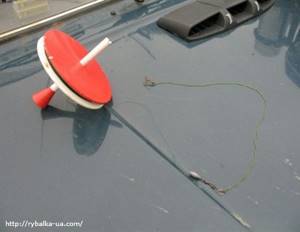
3. Bottom fishing This is done from an anchored boat. The bait is lowered to the seabed and held there using a suitable sinker. In cases where the fish does not stay close to the shore or when the bottom drops gradually, as well as during the surf, bottom fishing rods are used. Compared to float rods, bottom fishing rods have a significant advantage: they can be used for fishing in strong winds and high waves, at considerable depths and much further from the shore. “Donka” does not require a float; it swings from side to side. The method is used where the bottom is flat and there are no algae. 4. Spinning This method was invented at the beginning of the last century in England. Spinner baits of various shapes and sizes are used, which, when cast and pulled out of waters of different depths flowing at different speeds, casts all sorts of reflections, similar to the metallic shine of the scales of some fish. Predators buy into the “shine” and rush to the bait. 5. Trolling (fishing from a moving boat) This method was invented in Polynesia. Moving bait can be used to catch marlin, wahoo, sailfish and tuna. The movement of bait fish in the water should be as natural as possible. In the Leningrad region it can be used for fishing in the Gulf of Finland, Ladoga and other large bodies of water.
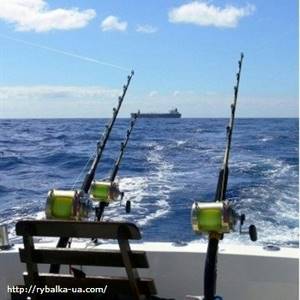
And finally, when all the fish are caught, it’s time to make fish soup out of it. It is believed that fish varieties such as pike perch, perch, and ruffe are best suited for fish soup; in second place are crucian carp, carp, carp, and chub. Preferably earthenware or enamel cookware; heat should be moderate. Here is a classic fish soup recipe: Place peeled and diced potatoes in boiling water. We also put whole, unpeeled onions in there; just wash and cut off the roots. Peel and finely chop the carrots and parsley root, add to the vegetables and cook for about 10 minutes.
In the meantime, we take care of the fish: we clean it from scales and entrails, cut it into pieces. Put bay leaf, pepper into the broth, add salt to taste and lower the perch. Cook everything together for another 15 minutes. After that, pour in vodka. It improves the taste of the finished dish, while also helping to eliminate the smell of mud, which is characteristic of some types of fish.
When the soup is ready, remove the bay leaf, pepper, onion and add butter. Before serving, add finely chopped herbs to each plate. Ingredients: perch – 1 kg; peeled onions – 2 pcs.; carrots (medium) – 1 pc.; potatoes – 4 pcs.; parsley root – 1 pc.; bay leaf – 3 pcs.; black pepper (peas) - 7 pcs.; butter – 1 tbsp. spoon; vodka – 70 ml; water – 2.5 l; salt, herbs - to taste.
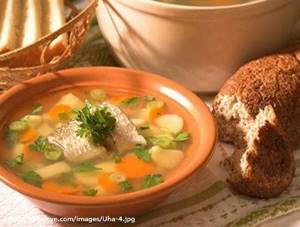
Recipe taken from womanadvice.ru. Photo: https://top-mest.ru/assets/images/niznii_novgorod/Ribalka-N.Novgorod2.jpg
Where to catch trout in the Leningrad region.
Friends, hello everyone!!! Today I wanted to talk about the last two days of my fishing before leaving on vacation to Karelia. Having read the title of my report, many probably thought that now I would finally find out the place where you can go and catch trout. Everything is possible and maybe after reading my report to the end you will understand that it is simple, or maybe you will tell me that you don’t need it.
So, you’ve seen enough beautiful videos and photos on the Internet and decided that you urgently need to catch trout, what do you need for this? And what you already have. I took up this issue several years ago and now I want to briefly tell you what I did.
To begin with, I want to say what two main desires you should have before going fishing. The first is to catch the trout, the second is to release the trout. There are several reasons for this, firstly, trout fishing in the Leningrad region is prohibited by law, and secondly, if you do not release the trout, then you will not catch it in this river again.
For several days in a row this week I went to practice fishing with fly fishing gear on one of the rivers in the Leningrad region. The road to the river runs through a forest with many difficult forest roads. No one showed me this road, and no one will show you anything either, I just went boom and got to the place I needed, which I had previously spotted on the map.
This time, of course, was not my first time here, but a couple of weeks ago it was like that. In this river I have mostly come across grayling, but I also caught trout a couple of times, very small in size.
Unfortunately, I arrived at the river after a good rain, which continued until almost lunchtime. Due to this, the water in the river became very cloudy, and it was almost impossible to catch fish. After wandering along the river for half an hour, I headed back to the car. Driving out of the forest, the idea came to me to explore a new place and I turned onto the road that led into the forest further than the place where I usually turned off from it.
The road was similar to the one left by timber trucks after the removal of felled forest. You can't drive through it on ordinary pussies. Looking at the navigator on my phone, I realized that the road should lead to another small river, which is a small tributary of the river from which I was returning.
Moving further and further, the road became worse and worse. After the last, old deforestation, the road became more suitable for an ATV than a car. At this point the road crossed the river, which interested me.
The river turned out to be very interesting in my opinion and, despite its small size, attracted me with its beauty.

Of course, it is possible to walk along such a river with a fly fishing rod, but it is very difficult and not convenient. Luckily, I had an ultra-light spinning rod in my car. I quickly gathered my gear, attached a small number one spinner and ran to the river.
Having walked literally fifty meters upstream, I caught the first spotted fish of a very small size. Having walked only a hundred meters in one direction and fifty meters in the other, relative to the road, I caught about five small, beautiful trout.
Realizing that this river required more reconnaissance, I collected my gear and went home. The next day I purposefully went to this river.
Returning to the conversation about what you need to catch a beautiful little fish, you should have already understood what you will need: the desire to go, if possible, alone in search of the necessary river; have a passable vehicle or the willingness to walk long distances through the forest; necessary gear (ultra-light spinning rod with a reel and cord for the corresponding spinning rod), a set of baits (spinners, micro-oscillators, silicone baits, etc.); You will also need the necessary equipment (wader boots and thermal underwear, at a minimum.
You need all this to go into the forest, to the river and catch a fish whose size in rare cases reaches a kilogram, but mostly these are specimens from 30 to one hundred grams, and after releasing it back into the river with a feeling of satisfaction, go home.
Armed with all of the above, I arrived at the river so that, having more or less passable transport, I could get almost to the place by car.
The weather in the morning was not bad, and I walked downstream along the river just a little over an hour before it flowed into the main river. The distance turned out to be not great; I didn’t even expect to get there so quickly. I caught it mainly on spinners and micro-oscillators. There weren’t many bites, but there were still some. The fish was small, not a single worthwhile specimen.
In the main river the water was still very muddy and there was no point in fishing there. I decided to go to the car and walk up the river as far as I could. At that moment it started to rain heavily and I got very wet. I left my rain jacket in the car because I didn't think I would get caught in the rain. The weather forecast promised that there would be no rain and I relaxed.
After the rain, the sun came out again and the dark forest began to be pierced by the sun's rays, everything was like in a fairy tale.

Only the fish refused to bite at first, and I sat down to drink tea while enjoying the beautiful landscape.

After walking the first hundred meters, I did not catch a single fish, although the day before at this place I caught several fish. Today, as if already knowing me, this fish looked at me from the dark water and laughed at me.
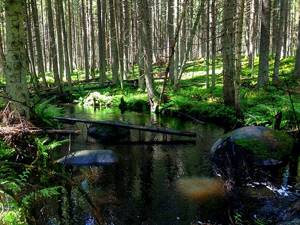
After walking another hundred meters, I caught the first small fish, moving upstream.
The river gradually became narrower and narrower and it seemed to me that it would only get worse and it was unlikely that I would wash anything else. All this time I was filming my journey on camera and then the camera told me that the memory card had run out.
At this moment I thought that I could make a couple of casts and slowly head towards the car. But suddenly, during the next cast, I felt a blow and resistance a little stronger than before, and the trout was already more decent on the hook.
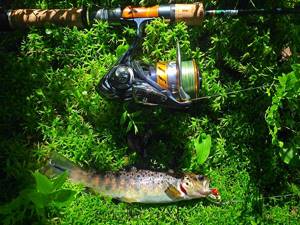
I even wanted to put a spare memory card in the camera and try to film the capture of such a beauty, but having received another dose of adrenaline, I moved forward, releasing the caught fish back into its element.
I also wanted to change the spinner to a spoon so as not to seriously injure the fish with the tee. But having caught another fish of the same size, I quickly took a photo, released the fish and cast again. So literally in one breath I walked another two hundred meters.

During these two or three hundred meters I caught several trout of this size. All of them, of course, look alike, but when you look closely you realize that each fish has its own beautiful coloring.
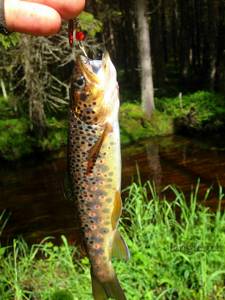
And the last couple were completely dark; now you can only see them in photographs. Of course, I released all the fish back into the river. I hope to come here one more time and catch them again to admire the bright spots.
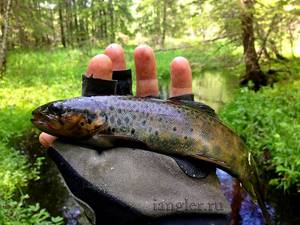
In fact, by this time the river had practically turned into a trickle. And there was nowhere else to fish, which means I crossed this entire river in almost a day, and if you take all the fish caught from it, then there will be practically no fish left in it.
Well, judge for yourself, even if you take this catch, what is there is not enough for the cat, but how much effort and money was invested in it?
So think about what is more interesting for you: investing money in expensive gear and returning home without a catch, or maybe it’s better to use feeder fishing rods and smoke bream?
Well, if you still want to get the dubious pleasure of some bright spots there and you still have one question, which river should you go to?
I will answer you, to the river closest to your house, where there is a current, and the water never gets warmer than 18-20 degrees. And of course, take into account the fact that wherever you can easily get to, poachers have already visited and caught everything they can, and the more people know about such places, the less chance of success.
Well, at the end, as usual, a video with my adventures. They say that those who fish for trout can determine the name of the river from a photograph and the color of the water, and even more so from a video. So, you better take a closer look, but those who found out, don’t write in the comments if this is the same river that flows behind my garden.
Similar articles:
Please rate the article
( 8 ratings, average: 4.88 out of 5)
